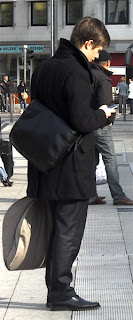Project: Dividing The Frame.
Exercise: Positioning the horizon.
For this exercise I found a viewpoint outdoors that gave a reasonably interesting landscape in which there was an unbroken and clear horizon.
I then took a short sequence of 6 photographs in which the horizon was placed at different positions in the frame from the top to the bottom.
 |
| 7239 |
In this photograph the horizon is placed at the top of the frame. I like this image because it has foreground detail and detail in the middle distance. The viewer's eye is encouraged to move between the foreground and background of the photograph.
 |
| 7238 |
Here the horizon has been placed in the centre of the frame. This has created quite a static composition. There is little foreground detail to help with the composition.
 |
| 7237 |
In this photograph the horizon has been placed just below the centre of the frame. This has given greater prominence to the interesting sky. The cloud formation gives 3 distinct areas of the frame. This makes a more interesting composition.
 |
| 7236 |
Here the horizon is placed approximately one third the frame height from the bottom of the frame. I find this photograph the most interesting because with the help of the cloud formation, the frame is divided roughly into thirds.
 |
| 7235 |
The horizon in this photograph is placed towards the bottom of the frame. The composition is quite dynamic. With the sky prominent, it gives the photograph a greater feeling of depth.
 |
| 7234 |
Here the horizon is placed at the bottom of the frame. The sky is very prominent. As there is little detail below the horizon the resulting composition is not very pleasing.
What have I learned from this exercise ?
A centrally placed division of the frame creates a very static composition. A higher or lower division will be more dynamic and give the picture a greater feeling of depth. Adding foreground detail makes the static effect of a centrally placed division less important.



















































